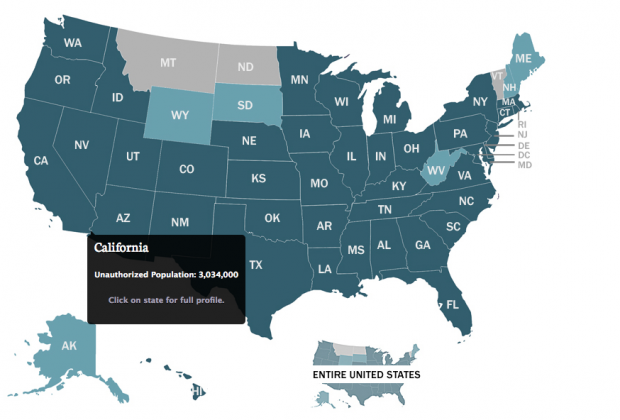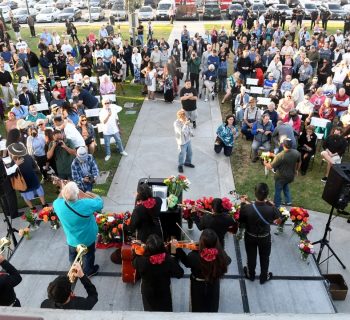Source: Migration Policy Institute (MPI) analysis of U.S. Census Bureau data from the 2013 American Community Survey (ACS), 2009-2013 ACS pooled, and the 2008 Survey of Income and Program Participation (SIPP) by James Bachmeier of Temple University and Jennifer Van Hook of The Pennsylvania State University, Population Research Institute. Data for the DACA estimates are modeled using U.S. Census Bureau data from the 2013 ACS and the 2008 SIPP in order to account for the required entry dates of June 2007 for the DACA program under the 2012 program rules and January 2010 under the 2014 expansions. Estimates of the deferred action program for parents are from U.S. Census Bureau, 2009-2013 ACS data and 2008 SIPP data.
Data-related notes
* “Top Industries of Employment” are those in which unauthorized immigrants were employed at the time of the survey or during the last five years. “Other services” are miscellaneous services, not including the following services listed separately: (1) professional, scientific, management, administrative, and waste management services; (2) educational, health and social services; and (3) arts, entertainment, recreation, accommodation, and food services.
** “Homeowners” are unauthorized immigrants residing in homes that are owned, not rented.
*** To be eligible for the original Deferred Action for Childhood Arrivals (DACA) program, as announced in June 2012, unauthorized immigrants must have entered the U.S. before age 16; have a high school degree or equivalent, or be enrolled in a qualifying education program; and be between ages 15 and 30. They must also have entered the U.S. by June 2007 (modeled as any time during 2007 in our data). The population immediately eligible for DACA excludes individuals who will age into eligibility when they reach their 15th birthday as well as those who lack a high school education and are not currently enrolled in school, but who may become eligible for DACA if they enroll in a qualifying adult education program. Additional criteria such as passing a criminal background check cannot be modeled. The DACA eligibility expansions announced in November 2014 included eliminating the maximum age of 30 and moving forward the date of initial required residence from June 2007 to January 2010. Our estimates include populations immediately eligible under the original 2012 DACA program as well as the expansions announced in November 2014.
**** The population eligible for Deferred Action for Parents of Americans and Lawful Permanent Residents (DAPA), as announced in November 2014, includes unauthorized immigrants residing continuously in the United States since January 2010 and who are parents of U.S. citizens or legal permanent residents (regardless of the child's age). The estimates for the DAPA program exclude individuals eligible for the DACA program. Additional criteria such as passing a criminal background check cannot be modeled.
- “School Enrollment of Children and Youth” refers to unauthorized immigrants who reported attending school or college at any time in the three months prior to the survey.
- For languages, "Chinese" includes Mandarin, Cantonese, and other Chinese languages; “English” includes English, Jamaican Creole, Krio, and Pidgin Krio; "French" includes French, Patois, French or Haitian Creole, and Cajun; “Hindi and related” includes Hindi, Urdu, Bengali, Punjabi, Marathi, Gujarati, Sindhi, Sinhalese, and Kannada; “Sub-Saharan African” includes Bantu, Swahili, Mande, Fulani, Kru, and other African languages; “Tagalog/Other Filipino” includes Tagalog, Bisayan, Sebuano, Llocano, and Hocano.
- “-“ estimates are zero, not applicable, or not displayed due to small sample size.
- Percentages may not add up to 100 due to rounding.
Methodology in Brief:
In the SIPP, noncitizens report whether they currently have LPR status—i.e., a green card. Those without LPR status may be recent refugees, temporary visitors (e.g., students or high-skilled H-1B workers), Temporary Protected Status (TPS) beneficiaries, or unauthorized immigrants. Our method maps characteristics such as country of birth, year of U.S. entry, age, gender, and educational attainment between the two surveys, and those noncitizens in the ACS who have characteristics similar to those reporting LPR status in the SIPP are coded as LPRs in the ACS. The remaining noncitizens—who are similar in characteristics to those not reporting LPR status in the SIPP—are classified as either unauthorized or legal temporary migrants, depending on whether they meet the qualifications for H-1B, TPS, and the other temporary classifications. This method was developed by Jennifer Van Hook of The Pennsylvania State University and James Bachmeier of Temple University. For more detail on the methods, see Jeanne Batalova, Sarah Hooker, Randy Capps, and James D. Bachmeier, DACA at the Two-Year Mark: A National and State Profile of Youth Eligible and Applying for Deferred Action (Washington, DC: Migration Policy Institute, 2014). Please note that these estimates use commonly accepted benchmarks from other research studies to determine the size of the unauthorized population and response rates to surveys. These estimates have the same sampling and coverage errors as any other survey-based estimates that rely on ACS and other Census Bureau data.
 Source: Migration Policy Institute
Source: Migration Policy Institute
http://www.migrationpolicy.org/data/unauthorized-immigrant-population/state/CA







